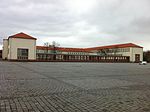Max Planck Institute of Microstructure Physics
The Max Planck Institute of Microstructure Physics in Halle (Saale) is a research institute in Germany in the field of materials research. It was founded in 1992 by Hellmut Fischmeister and is a follow-up to the German Academy of Sciences Institute of Solid State Physics and Electron Microscopy. The institute moved into new buildings from 1997 till 1999. It is one of 84 institutes in the Max Planck Society (Max-Planck-Gesellschaft). The institute has three main departments: The Theory Department, headed by Prof. Eberhard Gross, mainly carries out theoretical research on the electronic, magnetic, optical, and electrical properties of micro- and nanostructured solid-state systems'. The Experimental Department 1, headed by Prof. Jürgen Kirschner, mainly deals with the magnetic properties of dimensionally reduced systems and their dependence on electronic structure, crystalline structure and morphology. The Experimental Department 2, headed by Prof. Ulrich Gösele, is focussed on the scientific understanding, design and fabrication of new materials for information, communication, engineering as well as bio-technological applications.
Excerpt from the Wikipedia article Max Planck Institute of Microstructure Physics (License: CC BY-SA 3.0, Authors).Max Planck Institute of Microstructure Physics
Weinberg, Halle (Saale) Kröllwitz
Geographical coordinates (GPS) Address Nearby Places Show on map
Geographical coordinates (GPS)
| Latitude | Longitude |
|---|---|
| N 51.495277777778 ° | E 11.941388888889 ° |
Address
Weinberg 2
06120 Halle (Saale), Kröllwitz
Saxony-Anhalt, Germany
Open on Google Maps






